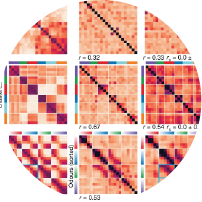Publications
 Structure and flexibility in cortical representations of odour space
—
The cortex organizes sensory information to enable perceptual discrimination and generalization. As systematic representations of chemical odor space have not yet been described in the olfactory cortex, it remains unclear how odor relationships are encoded to place chemically distinct but similar odors, such as lemon and orange, into perceptual categories, such as citrus. Here, by combining chemoinformatics and multiphoton imaging in the mouse, we show that both the olfactory cortex and its sensory inputs represent chemical odor relationships through correlated patterns of activity. Cortex actively builds a structured representation of chemical odor space that highlights proximal odor relationships; this representation is similar across individuals but remains flexible with learning, suggesting a means through which the olfactory system can assign related odor cues to common and yet personalized percepts.
Structure and flexibility in cortical representations of odour space
—
The cortex organizes sensory information to enable perceptual discrimination and generalization. As systematic representations of chemical odor space have not yet been described in the olfactory cortex, it remains unclear how odor relationships are encoded to place chemically distinct but similar odors, such as lemon and orange, into perceptual categories, such as citrus. Here, by combining chemoinformatics and multiphoton imaging in the mouse, we show that both the olfactory cortex and its sensory inputs represent chemical odor relationships through correlated patterns of activity. Cortex actively builds a structured representation of chemical odor space that highlights proximal odor relationships; this representation is similar across individuals but remains flexible with learning, suggesting a means through which the olfactory system can assign related odor cues to common and yet personalized percepts.
